Mushrooms have a deliciously woodsy flavor and are easy to prepare.
Use mushrooms in appetizers, salads, dips, soups, sauces, omelets, stews, pizzas, and pasta, or match them with meat, poultry, fish, and shellfish. Mushrooms can be sautéed, broiled, grilled, steamed, or stir-fried.
Favorite Mushroom Recipes
Oven Grilled Portobello Mushrooms
Oyster Mushroom Sautéed in Garlic
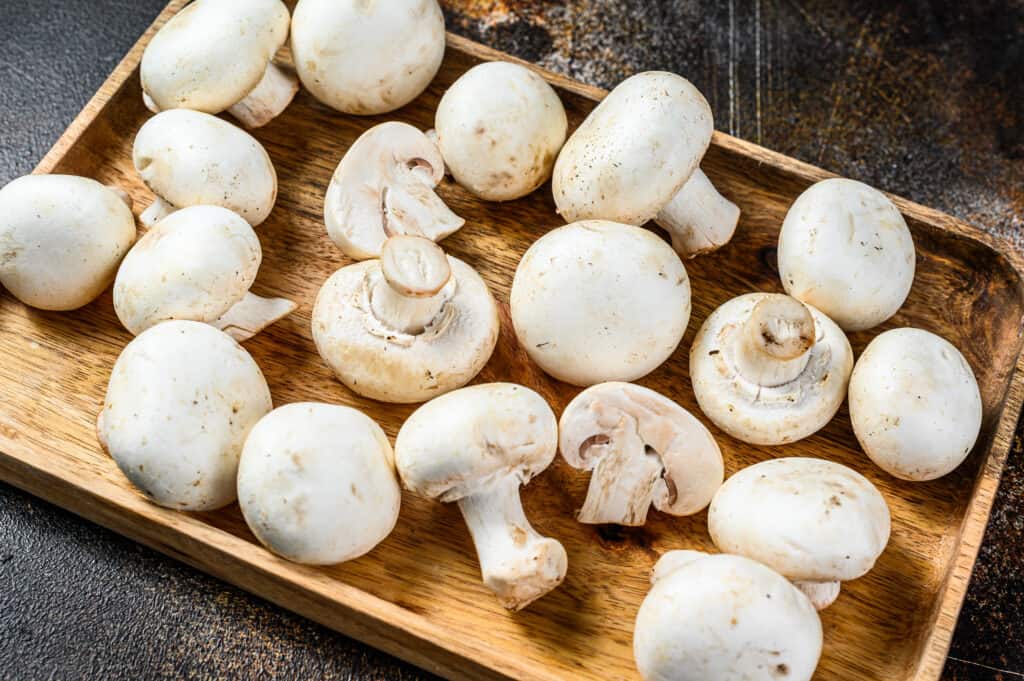
Cultivated mushrooms are available year-round. The peak season for many wild mushrooms is fall and winter.
How to choose mushrooms
- Select fresh mushrooms without blemish and without slimy spots or signs of decay.
- Button mushrooms should be smooth and plump with caps that are closed around the stems.
- Avoid spotted mushrooms and those with open caps that are dark and have exposed gills.
- To gather mushrooms in the wild you must be able to identify them properly. Some species are very poisonous others are of little use in cookery. If you have little knowledge or no experience with mushrooms choose only cultivated mushrooms.
How to store mushrooms
- Keep unwashed mushrooms wrapped in a paper towel, a single layer is best, in a plastic bag in the refrigerator for up to 4 days.
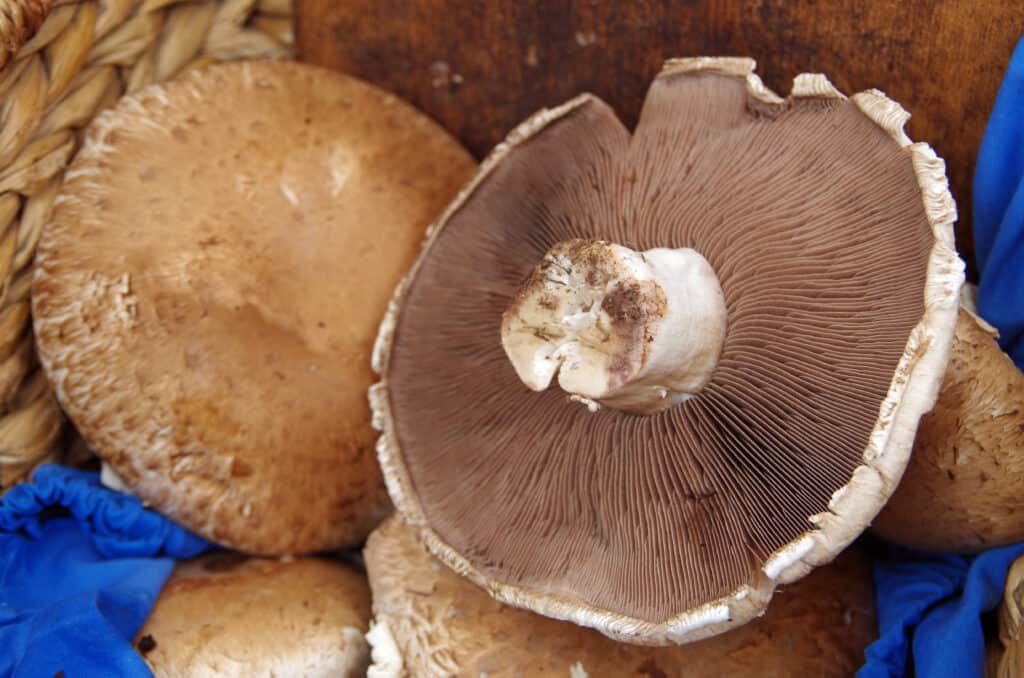
How to prep mushrooms
- Wipe mushrooms with a damp cloth or mushroom brush, or rinse under cold running water and pat dry.
- Trim and discard stem base; discard shitake stems.
- Use whole or slice lengthwise through the stem, or chop.
- Do not soak mushrooms before using them because they will absorb water and become mushy.
- Allow about ¼ pound per person when served as a vegetable.
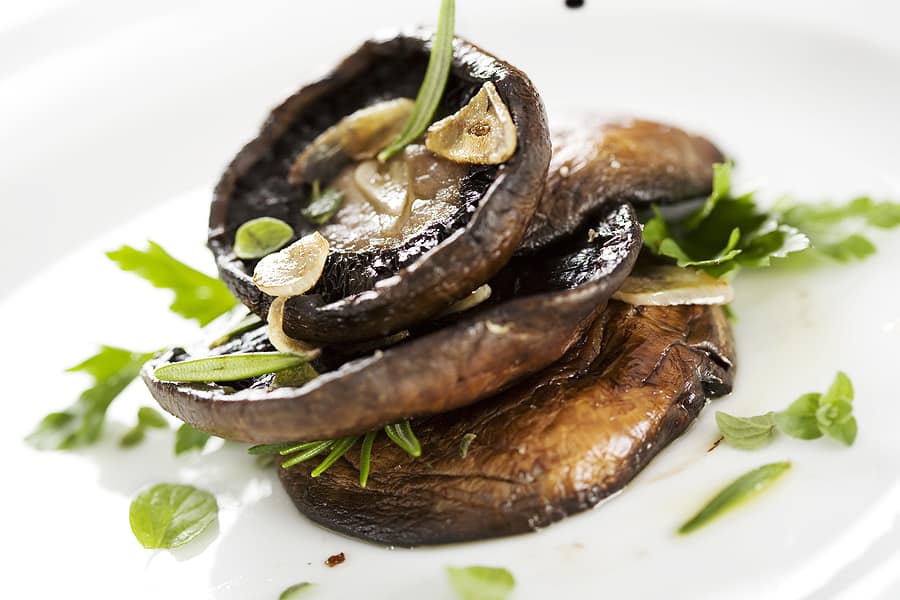
Mushroom serving suggestions
- Most mushrooms have a greater food value than green vegetables and many can be served alone as a main course. Mushrooms are favorites in both haute cuisine and traditional recipes.
- Serve raw with a dip for an appetizer.
- Slice and add to green salads or soups.
- Butter-steam slices and use to top hamburgers or place in omelets.
- Stuff large mushroom caps with sausage, breadcrumbs, or spinach to bake as a side dish or entrée.
- Dress with cheese sauce or melted butter seasoned with parsley, tarragon, thyme or dry sherry.
- Marinate small mushrooms in vinaigrette.
- Grill who portobello caps and serve burger-style.
- Add mushrooms to soup, chicken, and seafood dishes.
- Use shiitakes in Chinese and Japanese dishes.
- Stuff mushrooms caps with herbed breadcrumbs or chopped vegetables or risotto and broil them, or sauté mushrooms lightly with chopped shallots and parsley and a little thyme and serve them as a side dish.
- Simmer fresh mushrooms in red wine and tomatoes with parsley and serve as a main dish, or put a fat portobello mushroom on the grill and serve it just like a burger
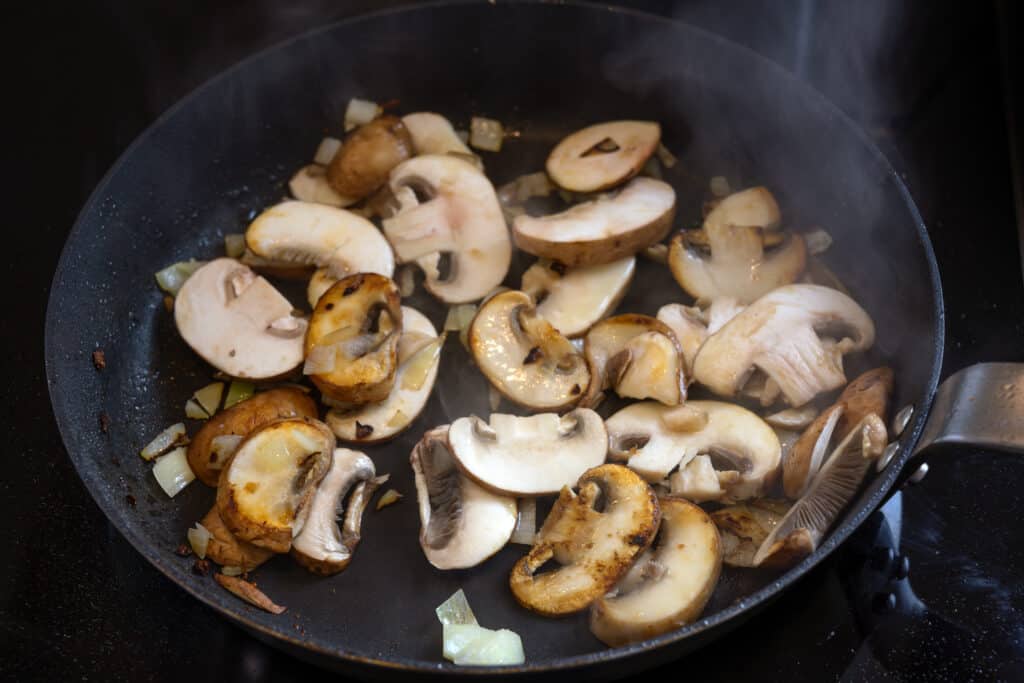
How to butter-steam mushrooms
- Cut mushrooms lengthwise into ¼-inch slices.
- Place up to 2 tablespoons of butter or margarine in a deep skillet over medium heat.
- Add the mushrooms and cook, stirring about 3 to 4 minutes.

How to grill mushrooms
Use button, portobello, or shitake mushrooms.
- Remove the stem ends to grill just caps or cut larger mushrooms down the middle and grill cap and stem together. Thread smaller mushrooms on skewers.
- Brush mushrooms with plain or seasoned vegetable oil, olive oil, or melted butter or margarine.
- Place rack about 4 inches above heat.
- Grill turning at least once until tender and lightly browned about 10 minutes.
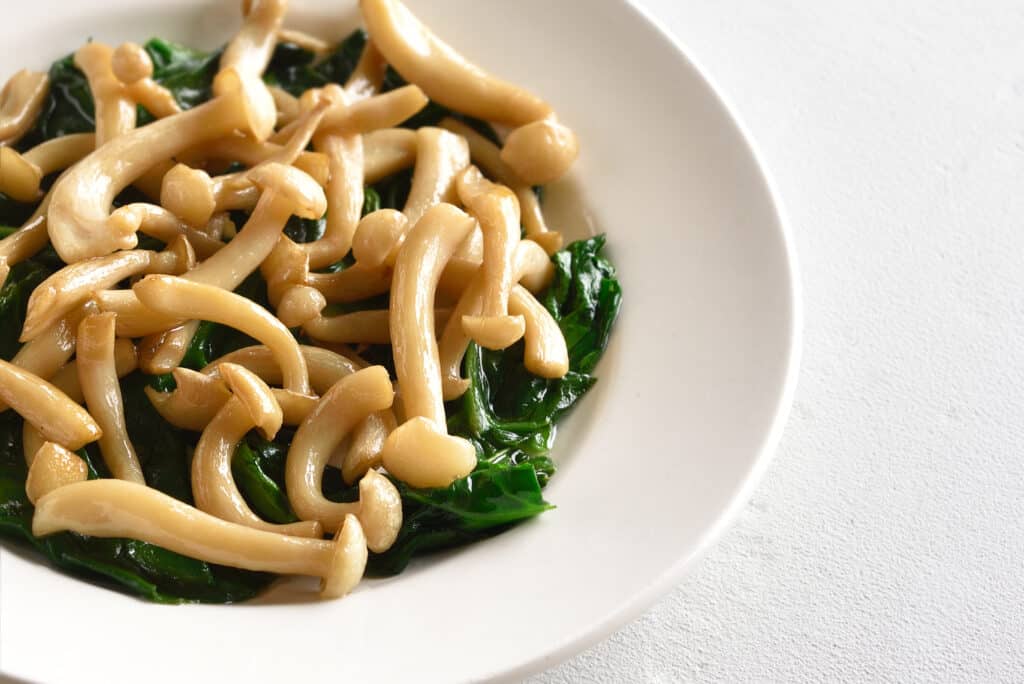
How to stir-fry mushrooms
- Cut mushrooms lengthwise into ¼-inch slices.
- Put 1 tablespoon vegetable oil in a skillet or wok
- Add the mushrooms and cook stirring until just soft about 3 to 4 minutes.
Mushroom flavor partners
- Mushrooms have a flavor affinity for beef, chicken, cream, fish and seafood, game, garlic, herbs, onion, pasta, pork, rice, and wine.
- Season mushrooms with salt, pepper, onion, garlic, mustard, dill, oregano, nutmeg, basil, paprika, parsley, sage, rosemary, or thyme.
- Serve mushrooms alone or with peas, beans, onions, corn, tomatoes, artichokes, bacon, or sausage or any of these combined. Top mushrooms with plain or flavored butter or margarine, vinaigrette dressing, or plain or flavored mayonnaise.
Mushroom nutrition
- Mushrooms are 89 percent water. They are high in potassium and riboflavin.
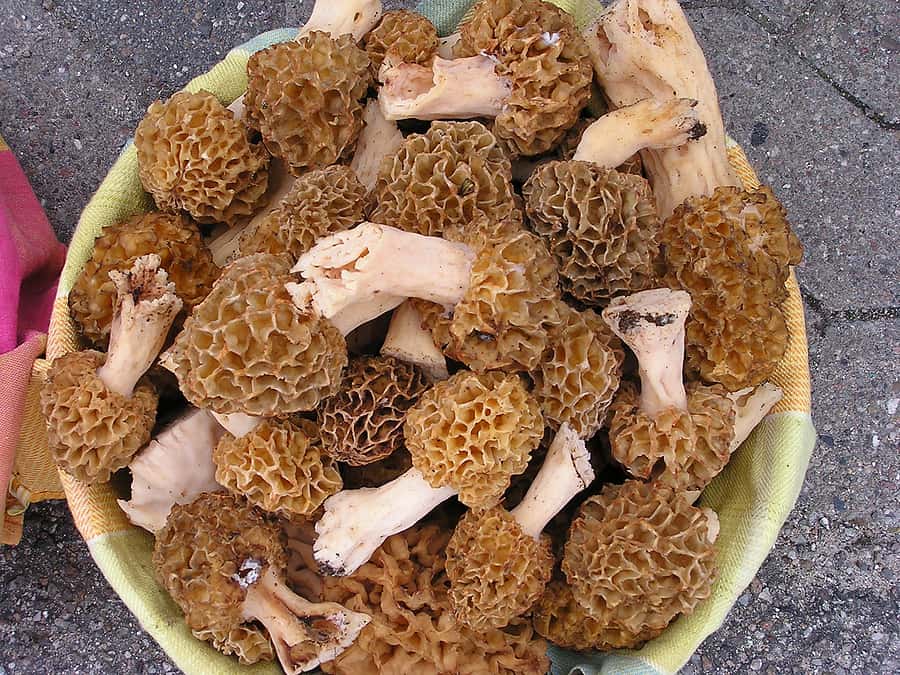
Cultivated mushroom varieties
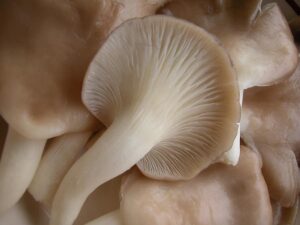
When it comes to cookery, the term mushroom refers generally to cultivated mushrooms.
Almost all of the mushrooms that you will take home from the market for use in the kitchen have been cultivated indoors under controlled conditions. The mushroom is a fungus and to keep the strain pure, mushroom growers work hard to keep all other fungi and bacteria out of the growing area.
The common white button mushroom has been in cultivation for hundreds of years. The first cultivated mushrooms were grown by the ancient Greeks and Romans. The commercial cultivation of mushrooms began in France during the rule of King Louis XIV in the seventeenth century.
Talk to your local mushroom grower to get the pedigree of mushroom varieties you are interested in. You will probably be able to find locally grown shiitake mushrooms that in years past grew only on logs in Japanese forests and truffles that once grew only under the roots of young oak trees in France.
There are more than 35,000 varieties of mushrooms, but only a few hundred of those are in general cultivation. Here are some of the best-known culinary mushrooms with their botanical names in parentheses:
• Black trumpets (Craterellus fallax): gray-brown to dark brown-black mushrooms that are 2 to 5 inches high with wavy-edged cap and an aromatic buttery flavor. Thin, brittle flesh.
• Button (Agaricus bisporus). Also known as the common or white mushroom. Plump and dome-shaped with a smooth texture and middle flavor. May be white, cream, or tan colored. Cultivated on a large scale. Known in France as Champignon de Paris. Simmer or add to soups. Good raw or cooked. Range in size from small buttons to jumbos suitable for stuffing or baking.
• Chanterelle (Cantharellus cibarius). Grow wild in the forests of the Pacific Northwest. The most common is the yellow or golden chanterelle with a wavy cup-shaped cap and no gills underneath. Apricot-like aroma and delicate nutty flavor. Choose ones that are plump and spongy. Avoid shriveled caps. Sauté or fry. Known as girolle in France.
• Cremini (Agaricus bisporus). Coffee-colored mushrooms with very good flavors that are very similar to common whites but with a deeper flavor. Cap is ½ to 2 inches in diameter. Cremino is singular. Sometimes called common brown mushroom and Roman mushroom.
• Enoki (Flammulina velutipes). Long stems to about 4 inches and tiny caps, small white mushrooms resemble bean sprouts with a mild flavor and slightly fruity odor. Delicate and should be eaten raw or briefly heated in a flavored broth. Choose firm and white ones. Use raw or in soups. Cultivated in California, Malaysia, and Japan.
• Hedgehog (Dentinum repandum). Buff colored caps with pale stems and tiny teeth (not gills) on the underside of the cap. Mild, sweet flavor and a firm, chewy texture. Cook before eating.
• Lobster (Hypomyces lactifluorum). Knobby appearance with a pimpled surface and a shellfish flavor and artichoke heart-like texture.
• Maitake (Grifola frondosa). Brownish gray mushroom with a tightly ruffled edge and a rich, woodsy taste that is enhanced by cooking. Sometimes called hen-of-the-woods. Also sometimes called the “king of mushrooms” because they can grow to as much as 50 pounds.
• Matsutake (Tricholoma matsutake). Dark brown, wild Japanese mushroom with dense meat and nutty flavor. Somewhat spicy, fruity aroma. Braise, grill, steam, and fry.
• Morel (Morchella esculenta). Rich and intensely earthy flavored with an odd texture; may be tan, yellow, or black with a short, thick stem and pointed cap. Almost always grown wild. An elongated dome from 1 to 5 inches high has a sponge-like appearance. The darker caps are most favored. Sometimes called sponge mushrooms. Choose firm, yet spongy ones. Heat in butter or simmer.
• Nameko (Pholiota nameko). Orange-brown caps are 2 to 3 inches in diameter. Soft, gelatinous texture with a rich, earthy aroma and flavor. Popular in Japan where it is used for soups on one-pot dishes. Sometimes called cinnamon cap.
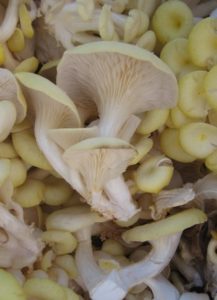
• Oyster or Pleurotte (Pleurotus ostreatus). Fluted, soft brown caps grow 1 to 3 inches in diameter. Grow wild and cultivated. Cultivated are white or black. The flesh is a smooth texture and a flavor something like seafood. Eat only the caps. Angel trumpets are an oyster hybrid that is larger and whiter. Sauté or fry.
• Porcini (Cèpes) (Boletus edulis). Rich, meaty flesh with fat, firm, stalks up to 10 inches high with a cap about 2½ to 6 inches across. Choose tan to pale brown ones that are not crumbly. Sauté or fry or eat raw.
• Portobello (Agaricus bisporus). The Portobello is a mature, larger version of the cremini with a cap that can be 6 inches in diameter. Solid, meaty texture and flavor.
• Puffball (Calvatia booniana). Firm, round, white mushroom from 4 ounces to more than 50 pounds. A mild, nutty flavor with a very meaty texture. Sauté.
• Shiitake (Lentinus edodes). Large, flat, dark brown mushrooms can be 8 to 10 inches across with a woody odor and rich mushroom or smoky flavor. Caps are soft and meaty. The stem is too tough to be eaten but can be used in stocks. Cultivated for more than 2,000 years. Choose plump mushrooms with edges that curl under. Sauté or fry. Sometimes called golden oak mushroom.
• Straw or Chinese (Volvariella volvaceae). Gray-brown caps are less than 1 inch tall with mild flavor and slippery texture. Used in Asian soups and stir-fries.
• Truffle (Tuber spp.). Edible fungi. The black truffle (Tuber melanosporum) is globe-shaped with small blackish warts. Usually grown in France. White truffle (Tuber magnatum) is irregularly shaped growing to about 4 inches in diameter. Sauté.
• White (Agaricus bisporus). The most well-known mushroom. Caps fit close to the stem. Creamy to beige color; good raw or cooked. Range in size from small buttons to jumbos suitable for stuffing or baking.
• Wood ear (Auricularia auricular-judae). Flat ear-like shape with a short stalk. Slightly crunch texture and delicate, bland taste that absorbs the flavors of other cooked ingredients. Popular in Asia. Sauté, stir-fry, or steam.
Get to know mushrooms
- There are more than 35,000 species of mushrooms. Most of them are not edible, and some of them are poisonous. Unless you are a mushroom expert, choose cultivated mushrooms. There are dozens of cultivated mushrooms to choose from with many different flavors and textures.
- The mushroom is not a vegetable; it is a fungus, which means it is a plant that has neither chlorophyll, which vegetables use to form simple carbohydrates and sugars, nor leaves, flowers, or roots.
- Without chlorophyll, mushrooms must draw nutrition from existing organic materials where they grow. Most mushrooms grow in cool, damp places like woodlands and meadows where the soil is rich in humus, a source of food for the mushroom.
- Mushrooms grow in a range of colors from white to black and in a variety of shapes and sizes. Some mushrooms have short stems, some long stems. Some have button caps, some have pointed, conical caps and some have flat, wide caps. Mushrooms can be smooth textured or pitted, or honeycombed, or ruffled. The flavor of mushrooms can vary from bland to rich and from nutty to earthy.
- Mushrooms have been cultivated for thousands of years. The ancient Greeks and Roman ate cultivated mushrooms.
- The word mushroom was first recorded in the fifteenth century. It was borrowed from the Old French mousseron which can be traced back to the Latin word mussiriō, a word of unknown origin.
Articles of interest:
Best Herbs for Container Growing
Garden Planning Books at Amazon:
- Vegetable Garden Almanac & Planner
- Kitchen Garden Grower’s Guide Vegetable Encyclopedia
- Vegetable Garden Grower’s Guide
- Tomato Grower’s Answer Book
More kitchen tips:
Bring your harvest to the table. Kitchen prep tips and easy recipes for the vegetables you grow. Click below for vegetable prep and recipes you can use now.
- Almonds
- Apples
- Apricot
- Aprium
- Artichoke
- Arugula
- Asparagus
- Avocado
- Bamboo Shoots
- Banana
- Basil
- Beans, Dried
- Beans. Long
- Beans, Shell
- Beans, Snap
- Beets
- Bitter Melon
- Blackberry
- Bok Choy
- Broccoli
- Broccoli Raab
- Brussels Sprouts
- Cabbage
- Cardoon
- Carrots
- Cauliflower
- Celeriac
- Celery
- Chard
- Chayote Squash
- Cherimoya
- Cherries
- Chestnut
- Chickpea
- Chinese Cabbage
- Chives
- Cilantro
- Citron
- Clementine
- Collards
- Coriander
- Corn, Sweet
- Corn, Baby
- Corn Salad, Mache
- Cranberry
- Cress
- Cucumber
- Daikon
- Dandelion
- Dill
- Eggplant
- Endive, Belgian
- Endive and Escarole
- Fava Beans
- Fig
- Florence Fennel
- Garlic
- Ginger
- Grapefruit
- Grapes
- Guava
- Horseradish
- Jerusalem Artichoke
- Jicama
- Jujube
- Kale
- Kiwifruit
- Kohlrabi
- Kumquat
- Leeks
- Lemongrass
- Lemons
- Lettuce
- Lime
- Mache (Corn Salad)
- Mandarin Orange
- Mango
- Maple Syrup
- Marjoram
- Melons
- Michihili
- Mint
- Mizuna
- Mushrooms
- Mushrooms, Cremini
- Mustard Greens
- Napa Cabbage
- Nectarine
- Okra
- Olives
- Olive oil
- Onions
- Oranges
- Oregano
- Parsley
- Parsley Root
- Parsnips
- Passion Fruit
- Pawpaw
- Peaches
- Pears
- Peas, Garden Snap
- Peas, Snow
- Pei Tsai
- Peppers, Chili
- Peppers, Sweet
- Persimmon
- Pineapple
- Pineapple Guava
- Plantain
- Plums
- Pluots
- Pomegranate
- Potatoes
- Prickly Pear
- Pumpkin
- Quince
- Radicchio
- Radishes
- Raspberries
- Rosemary
- Rhubarb
- Rutabaga
- Sage
- Salsify
- Sauerkraut
- Savory
- Shallots
- Sorrel
- Spinach
- Squash, Summer
- Squash, Winter
- Strawberries
- Sunchokes
- Sunflower
- Sweet Potato
- Swiss Chard
- Tangerine
- Taro
- Tarragon
- Thyme
- Tomatillo
- Tomato
- Turnip
- Turnip Greens
- Yams















